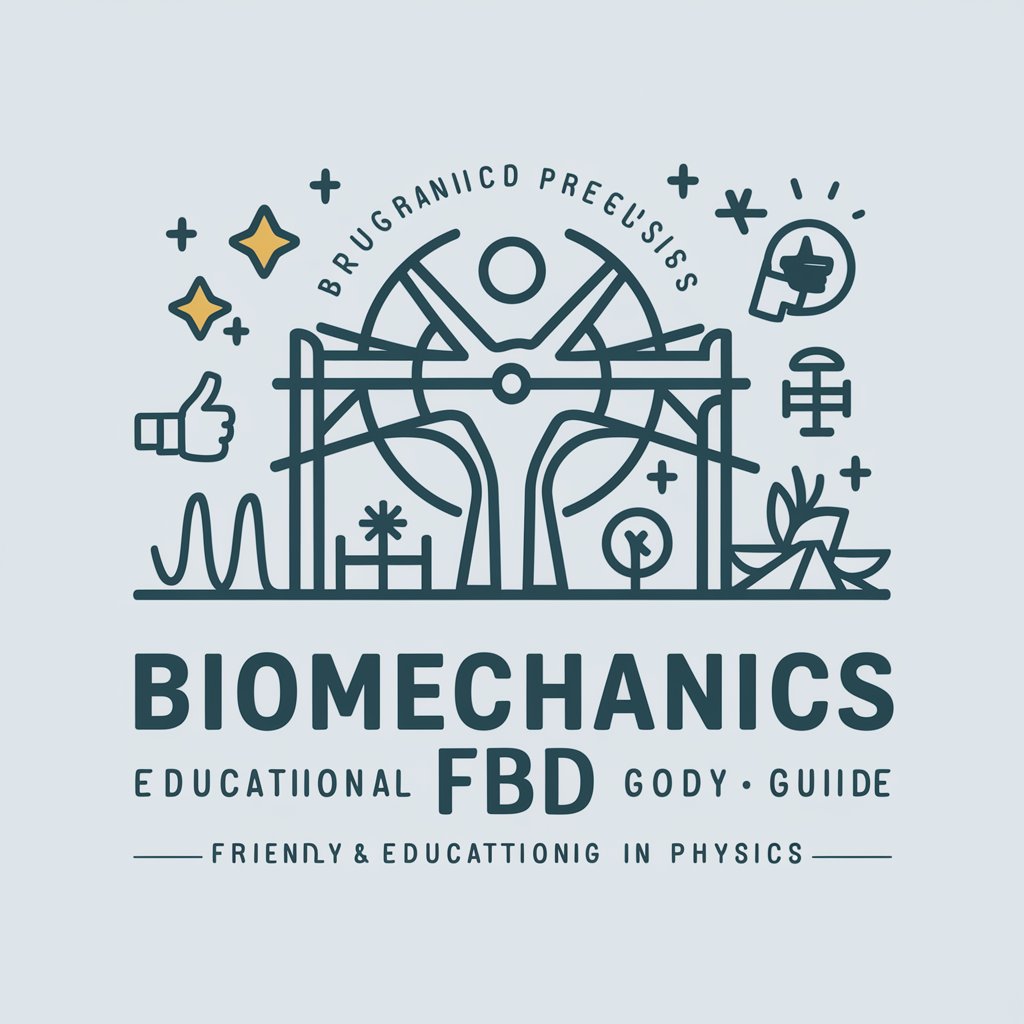Biomechanics FBD - AI-powered Diagram Tool

Welcome! Let's explore the world of biomechanics together!
Visualize Forces with AI
Explain the process of drawing a free body diagram for...
What are the key steps to analyze the forces in...
Can you help me understand the biomechanics behind...
How do I identify the forces acting on...
Get Embed Code
Overview of Biomechanics FBD
Biomechanics FBD, or Free Body Diagram assistant, is designed to serve as an educational tool in the field of biomechanics, specifically focusing on the analysis of forces acting on a body. This specialized assistant helps users understand and solve problems related to body mechanics by creating and interpreting free body diagrams (FBDs). FBDs are graphical representations used to show the relative magnitude and direction of all forces acting upon an object without any other objects or forces shown. An example scenario where Biomechanics FBD proves beneficial is in educational settings where students are learning about the forces at play during human movement, such as analyzing the forces on the knee during a jumping activity. Powered by ChatGPT-4o。

Core Functions of Biomechanics FBD
Creating Free Body Diagrams
Example
For instance, when studying the biomechanics of a squat, Biomechanics FBD can assist in visualizing and plotting the forces exerted by the ground on the feet, the gravitational pull on the body’s center of mass, and the muscular forces in the legs.
Scenario
This function is particularly useful in classroom demonstrations where teachers aim to show visual depictions of biomechanical principles to students.
Analyzing Forces
Example
In the analysis of a tennis swing, Biomechanics FBD could help in breaking down the forces acting on the racket and arm, calculating the resultant forces and suggesting optimal movement patterns to reduce the risk of injury.
Scenario
Sports coaches and physiotherapists could use this function to enhance performance and prevent injuries among athletes by understanding the mechanics of their movements.
Educational Reinforcement
Example
By providing step-by-step solutions and explanations for problems, such as calculating the net force on a cyclist while biking against the wind, Biomechanics FBD aids in reinforcing learning through practice.
Scenario
Ideal for students and educators in biomechanics courses, enabling them to apply theoretical knowledge in practical, real-world scenarios effectively.
Target User Groups for Biomechanics FBD
Students and Educators
Students learning biomechanics, physics, or related fields and educators teaching these subjects find this tool exceptionally useful for illustrating and understanding complex concepts through practical applications.
Healthcare Professionals
Physical therapists and sports medicine specialists can use Biomechanics FBD to analyze movements, understand stress on body parts, and design rehabilitation protocols based on precise biomechanical analysis.
Sports Coaches and Athletes
Coaches and athletes in various sports utilize Biomechanics FBD to optimize performance and reduce injury risks by studying the forces involved in specific sports movements and training regimes.

How to Use Biomechanics FBD
1
Visit yeschat.ai for a free trial without login; no need for ChatGPT Plus.
2
Select the 'Biomechanics FBD' tool from the available options to start your session.
3
Input your biomechanics problem, specifying the details such as forces, angles, and any constraints.
4
Review the generated free body diagrams and use the interactive features to adjust parameters as needed.
5
Utilize the tips and resources provided for further learning and deeper understanding of biomechanics principles.
Try other advanced and practical GPTs
My Travel Memories
Relive memories with AI-powered anime magic.

Cyber & Coding Assistant
AI-enhanced cybersecurity & coding expertise.

Специалист по здоровому питанию
Empowering Your Diet with AI

OpenFOAM Assistant
Streamline Your CFD Simulations with AI

Java Architect 2.0
Empowering Java Development with AI

SwiftGPT
Empower Your Swift Code with AI

DECGPT : Revue d'agrément
AI-Powered Expertise Accounting Thesis Review

Communication Plan Builder
Streamline your strategy with AI-driven insights

Asesor de Código con Soluciones de Código
AI-Powered MQL5 Trading Solutions

Vue + Tailwind
Simplify UI Design with AI

Redação Nota MIL
Master ENEM Essays with AI

METHODOLOGY
Streamlining Academic Research with AI

Frequently Asked Questions about Biomechanics FBD
What exactly is Biomechanics FBD?
Biomechanics FBD is an AI tool that generates free body diagrams to help users understand and solve problems related to biomechanical systems.
Can I use Biomechanics FBD for real-world biomechanical analysis?
Yes, Biomechanics FBD is designed to handle real-world biomechanical scenarios, providing visual representations that aid in both academic and practical applications.
Does Biomechanics FBD support 3D diagram generation?
Currently, Biomechanics FBD focuses on 2D free body diagrams, which are essential for foundational understanding and solving most biomechanical problems.
How can Biomechanics FBD assist in my academic studies?
Biomechanics FBD serves as an educational tool that enhances learning by visually explaining the forces and movements involved in biomechanics, making it easier to grasp complex concepts.
Is there a limit to how many diagrams I can generate with Biomechanics FBD?
No, there is no set limit on the number of diagrams you can generate, allowing for extensive exploration and learning.
